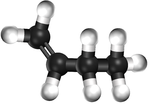Contents
Key Stage 4
Meaning
Alkenes are hydrocarbon compounds with one double bond and the general formula; CnH2n
About Alkenes
- Alkenes are a homologous series of hydrocarbon compounds.
- The functional group of the Alkenes is the double bonds between the Carbon atoms.
- Alkenes are long chains of Carbon atoms covalently bonded together with double and single bonds and Hydrogen atoms taking the remaining bonds.
- Alkenes are referred to as unsaturated hydrocarbons because the double bond means it is not saturated (full) with Hydrogen atoms.
- Testing for alkenes can be done by adding them to Bromine Water. If the Bromine Water turns from orange to colourless, then an alkene is present. During this test the Bromine reacts with the alkene to form a Bromoalkane.
- Ethene + Bromine → Dibromoethane
- C2H4 + Br2 -> C2H4Br2
Examples
| Ethene | Propene | But-1-ene | But-2-ene | |
| Chemical Formula (CnH2n) | C2H4 | C3H6 | C4H8 | C4H8 |
| Structural Formula | CH2CH2 | CH2CHCH3 | CH2CHCH2CH3 | CH3CHCHCH3 |
| Structural Diagram | ||||
| Ball and Stick Model |
Reactions of Alkenes
Combustion
During combustion of alkenes the Carbon and Hydrogen atoms are oxidised to produce Carbon Dioxide and Water.
Complete Combustion
Complete combustion occurs when there is enough Oxygen to completely Oxidise all of the atoms in the alkene. In the complete combustion of alkenes the only products are Carbon Dioxide and Water.
- Ethene + Oxygen → Carbon Dioxide + Water
- <chem>C2H4 + 3O2 -> 2CO2 + 2H2O</chem>
- Propene + Oxygen → Carbon Dioxide + Water
- <chem>2C3H6 + 9O2 -> 6CO2 + 6H2O</chem>
- Butene + Oxygen → Carbon Dioxide + Water
- <chem>C4H8 + 6O2 -> 4CO2 + 4H2O</chem>
Incomplete Combustion
Incomplete combustion occurs when there is not enough Oxygen to Oxidise all of the atoms in the alkene. During incomplete combustion of alkenes the products may include Carbon (soot) and Carbon Monoxide.
- Ethene + Oxygen → Carbon Monoxide + Water
- <chem>C2H4 + 2O2 -> 2CO + 2H2O</chem>
- Ethene + Oxygen → Soot + Carbon Monoxide + Water
- <chem>2C2H4 + 3O2 -> 2C + 2CO + 4H2O</chem>
Reaction with Halogens
When halogens are added to alkenes the double bond in the alkenes breaks and the halogens bond in its place.
Reaction with Hydrogen
Alkenes can be saturated with extra Hydrogen using a catalyst.
Reaction with Steam
Alkenes can react with steam to produce alcohols using a catalyst.







